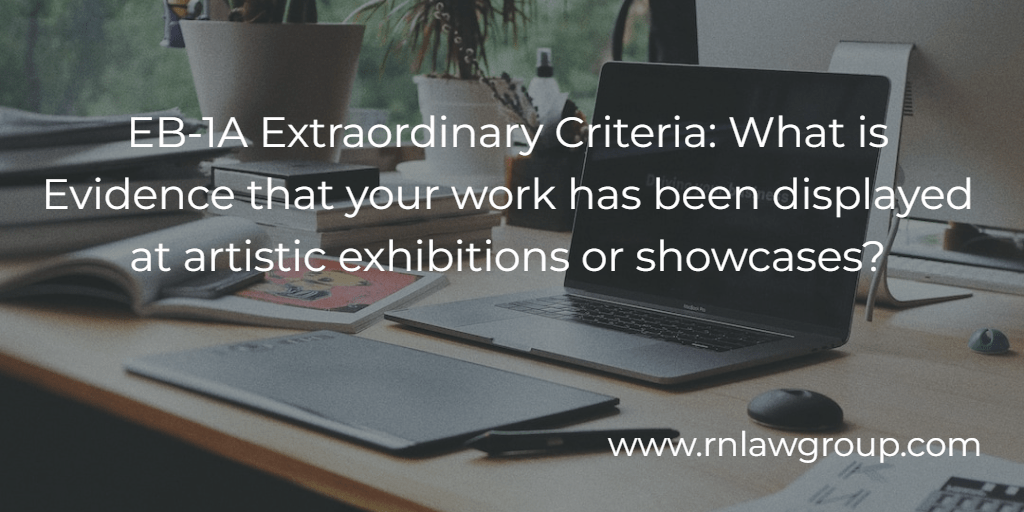
EB-1A Extraordinary Criteria: What is Evidence that your work has been displayed at artistic exhibitions or showcases?
The EB-1A employment-based immigration visa can appear to be a daunting process. An applicant must either show proof of a one-time achievement (major internationally-recognized award) meet 3 of the 10 listed criteria:
- Evidence of receipt of lesser nationally or internationally recognized prizes or awards for excellence
- Evidence of your membership in associations in the field which demand outstanding achievement of their members
- Evidence of published material about you in professional or major trade publications or other major media
- Evidence that you have been asked to judge the work of others, either individually or on a panel
- Evidence of your original scientific, scholarly, artistic, athletic, or business-related contributions of major significance to the field
- Evidence of your authorship of scholarly articles in professional or major trade publications or other major media
- Evidence that your work has been displayed at artistic exhibitions or showcases
- Evidence of your performance of a leading or critical role in distinguished organizations
- Evidence that you command a high salary or other significantly high remuneration in relation to others in the field
- Evidence of your commercial successes in the performing arts
These criteria can make even very well qualified candidates nervous about their eligibility, but with the right experience, the right lawyer, and a little luck, an applicant can have their Green Card in as little as three months. This series of articles will provide a background on each of the 10 criteria, examples of documents that can meet them, and common pitfalls to avoid.
In the field of creative expression, exhibitions and showcases of the arts are of great importance. They provide platforms for artists to communicate their ideas, viewpoints, and skills to a larger audience. Exhibitions provide artists with chances for networking, collaboration, and exposure to critical input in addition to their aesthetic and cultural worth. These occasions can have a significant impact on an artist’s trajectory, frequently resulting in increased notoriety, sales, and invitations to take part in more esteemed shows.
From the perspective of immigration, creative shows and showcases offer verifiable proof of a person’s influence within their area. Public display of one’s work denotes that the artist’s creations have attained a caliber and relevance that justifies acknowledgement. This requirement fits with the goal of the EB-1A visa, which is to draw applicants who have attained notoriety and influence in their particular fields.
The language used in the EB-1A visa requirement for creative exhibitions or showcases is purposefully vague. As a result of this versatility, a variety of exhibitions can be taken into account, accommodating the diversity of artistic expression across numerous mediums. The particular requirements may vary depending on the sort of artistic work, but the fundamental requirement—proving that the work has been acknowledged and shown in a professional setting—remains the same.
Exhibitions that qualify could be:
- Solo Exhibitions: A solo exhibition is a display of a single artist’s creative output. It is frequently seen as a crucial turning point in an artist’s career and shows their capacity to maintain a body of work deserving of public display.
- Group shows: Taking part in group shows demonstrates an artist’s capacity for peer collaboration and allows them to add their distinct viewpoint to a greater artistic discussion.
- Shows that are judged: For these shows, artists must submit their work to be evaluated by a group of professionals. Acceptance into such exhibitions is a testament to the artist’s talent and adherence to acknowledged creative standards.
- Invitation-only exhibits: Invitation-only exhibitions indicate that curators and organizers are interested in and value an artist’s work.
- Exhibitions: Placing artwork on display in commercial galleries highlights a creator’s financial potential and appeal to art buyers and aficionados.
- Exhibitions in museums: Being included in a museum exhibition carries a lot of prestige since it shows that organizations committed to conserving and promoting culture and art have taken notice of you.
In order to successfully apply for an EB-1A visa under the criterion of creative exhibitions or showcases, a solid body of evidence must be gathered. A persuasive argument illustrates the artist’s influence, authority, and ongoing contributions to their profession. Consider the following essential components to create a strong argument:
- Documentation: It’s essential to provide in-depth documentation for the exhibitions. This could include news coverage, invitations, programs, images of the artwork on show, and exhibition catalogues.
- If they are accessible, curatorial comments or evaluations that explain the artist’s work in relation to the exhibition might provide the evidence more context and depth.
- The repute of the places where the exhibitions were held should be highlighted. The credibility of the artist’s participation might be increased by mentioning the relevance of the galleries, museums, or other organizations.
- Describe the extent of your participation in the exhibitions. Did the artist play a substantial role in the exhibition’s curation or planning? Did they take part in any workshops or panel discussions that were linked to the exhibition?
- Impact: Provide proof of the exhibitions’ beneficial effects on the artist’s career. This might be sales statistics, invites to upcoming exhibitions, or positive reviews.
- Expert Testimonials: Letters of recommendation from professionals in the area who can attest to the accomplishments and influence of the artist can offer a different viewpoint.
- The artist’s continued contributions to the area are reinforced through a regular pattern of involvement in shows over time.
Evidence Required as Proof:
- It is important to include documentation that demonstrates the importance and acknowledgment of awards when providing proof of receiving smaller prizes or medals for excellence. The following proof might be needed:
- Copies of the official award certificates or letters that clearly state the recipient’s name, the awarding organization, the award’s requirements, and the degree of recognition received are known as award certificates or letters.
- Strong letters of support from authorities or professionals in the field that witness to the importance of the award, the standing of the organization giving it, and the relevance of the recipient’s accomplishments.
- Coverage in the media: articles, news releases.
Common difficulties and issues that may come up during the Request for Evidence (RFE) phase of the EB-1A visa application include the following:
- Lack of Adequate Documentation: One of the most frequent mistakes is failing to offer adequate proof or documentation to support the importance and acknowledgment of the showcases. It is essential to provide comprehensive details regarding the awarding organization, the selection procedure, and the qualifying requirements.
- Insufficient Justification of the Showcase’s Importance: The adjudicating officer may ask for more information about the significance of the showcase in relation to the particular field. It is imperative to describe how the showcase is recognized on a national or international level and how it exemplifies greatness in the field.
- Lack of Expert Opinion: RFEs may ask for further expert opinion letters from people who are well-known in the industry. The claim that the showcases are nationally or internationally renowned and show outstanding talent should be supported by these letters’ in-depth study.
- Insufficient Selectivity Documentation: If the selectivity of the showcasing organization is not sufficiently documented, an RFE may doubt the strictness of the selection procedure. This problem can be solved by providing information on the organization’s reputation, the quantity of applications, and the selection criteria.
- Insufficient Field Information: RFEs may ask for more details regarding the field in which the applicant is exhibiting outstanding aptitude. This could demonstrate the importance of the field, recent developments, and the effect of the individual’s work.
- Lack of Support: In some circumstances, an RFE may raise concerns about the legitimacy or veracity of the showcase. These issues can be addressed by offering more proof, such as quotes from others, testimonials, or independent verification of the prizes.
- Older or Inapplicable showcases: An RFE may ask for more recent or field-specific showcases to demonstrate a person’s present remarkable ability if the ones offered are old or unrelated to their accomplishments or area.
- Insufficient Justification of the Field’s Importance: The adjudicating officer could need more explanation of the field’s significance. It is crucial to discuss the field’s significance, recent developments, and individual contributions in the context of the overall field.
- Lack of Context: RFEs could raise concerns about the degree of competition or the importance of the showcase in the context of the field. These issues can be addressed by providing comparative facts, such as the quantity of applicants, acceptance rates, or expert testimonials.
- RFEs may be issued as a result of any anomalies or inconsistencies in the application materials or supporting papers. It is essential to make sure that the application is accurate and consistent throughout.
When responding to an RFE, it’s crucial to pay close attention to every point stated, offer more information or explanation as needed, and make sure the response clearly displays the person’s exceptional skill and standing in their industry. In order to successfully navigate the RFE process and write a compelling answer, it can be helpful to consult with an experienced immigration lawyer.
By: Karim Jivani
Karim Jivani is a Special Attention Staff Attorney at Reddy Neumann Brown PC who focuses on employment-based non-immigrant visas. Karim’s practice covers all phases of the visa process including filing petitions, responding to Requests for Evidence (RFE), and drafting motions and appeals. He has completed over 30 RFE’s to date in response to H-1B, L-1, I-140, and VAWA petitions.

